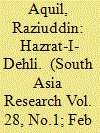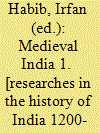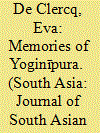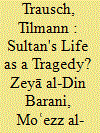|
|
|
Sort Order |
|
|
|
Items / Page
|
|
|
|
|
|
|
| Srl | Item |
| 1 |
ID:
080817


|
|
|
|
|
| Publication |
2008.
|
| Summary/Abstract |
This article explores the significant linkages between the rise of Delhi as the foremost Sufi centre and the bastion of Islam as well as the seat of political power in the 13th and 14th centuries. Three out of the first five leading Chishti saints of the Sultanate period chose to live in Delhi, catapulting the city onto the map of the sacred geography of South Asian Islam. The Chishti Sufis also helped in shaping the cosmopolitan character of the city, even as they ensured that the interests of Islam and Muslims were safeguarded. Hence, though Delhi remained the centre of Muslim power for close to six centuries and its landscape is dotted with mosques, madrasas and dargahs of the Sufis, the exclusionist, juridical interpretation of Islam was sidelined in favour of a more inclusive approach to religion practised and propagated by the Chishtis. The essay charts this process and its significance for the early history of Islam in India
|
|
|
|
|
|
|
|
|
|
|
|
|
|
|
|
| 2 |
ID:
089356


|
|
|
|
|
| Publication |
2009.
|
| Summary/Abstract |
The consolidation of the Delhi Sultanate coincided with the Mongol devastation of Transoxiana, Iran and Afghanistan. This paper studies the Persian literature of the thirteenth and fourteenth centuries invested as it was in the projection of the court of the Delhi Sultans as the 'sanctuary of Islam', where the Muslim community was safe from the marauding infidel Mongols. The binaries on which the qualities of the accursed Mongols and the monolithic Muslim community were framed ignored the fact that a large number of Sultanate elites and monarchs were of Turkish/Mongol ethnicity or had a history of prior service in their armed contingents. While drawing attention to the narrative strategies deployed by Sultanate chroniclers to obscure the humble frontier origins of its lords and masters, my paper also elaborates on steppe traditions and rituals prevalent in early-fourteenth-century Delhi. All of these underlined the heterogeneity of Muslim Sultanate society and politics in the capital, a complexity that the Persian litterateurs were loath to acknowledge in their records.
|
|
|
|
|
|
|
|
|
|
|
|
|
|
|
|
| 3 |
ID:
001543


|
|
|
|
|
| Publication |
DelhI, Oxford University Press, 1999.
|
| Description |
vii, 224p.pbk
|
| Series |
Centre of Advanced Study in History
|
| Standard Number |
0195646584
|
|
|
|
|
|
|
|
|
|
|
|
Copies: C:1/I:0,R:0,Q:0
Circulation
| Accession# | Call# | Current Location | Status | Policy | Location |
| 041112 | 954.02/HAB 041112 | Main | On Shelf | General | |
|
|
|
|
| 4 |
ID:
154553


|
|
|
|
|
| Summary/Abstract |
This paper discusses the lengthy eulogies (praśasti) framing the Apabhraṃśa-language compositions of Raïdhū, a Digambara Jaina from early-fifteenth-century Gwalior. In these praśastis, the patron of the work, his family and their noteworthy deeds are immortalised by the poet. Many of these patrons, all of them merchants, had ancestors living in Delhi, here named Yoginīpura, who seem to have migrated to Gwalior and elsewhere around the time of Timur's sack of Delhi in 1398. Despite its frequent mention, Yoginīpura itself is nowhere described by Raïdhū, possibly in order to avoid stirring up memories of Timur's onslaught just decades prior.
|
|
|
|
|
|
|
|
|
|
|
|
|
|
|
|
| 5 |
ID:
186553


|
|
|
|
|
| Summary/Abstract |
This article examines how Zeyā al-Din Barani may have imagined that contemporary audiences would consume his Tārikh-e Firuz Shāhi. Would it only be read visually or also read aloud (directed at the ear rather than the eye), and thus be received aurally, or would it even be performed in front of a larger audience? The plot and protagonists of Barani's story on Moʿezz al-Din Keyqobād present a tragedy that develops around a sultan doomed to fail. An examination of the set-up of Barani's narrative reveals that it contains numerous textual devices that would enable a storyteller to perform the story, using the text as a kind of tumār. As tragedies are written for the stage, not the study, these features of the text indicate that matters of orality, which are crucial for many genres of premodern Persianate courtly literature, are also relevant to the Tārikh-e Firuz Shāhi.
|
|
|
|
|
|
|
|
|
|
|
|
|
|
|
|
|
|
|
|
|